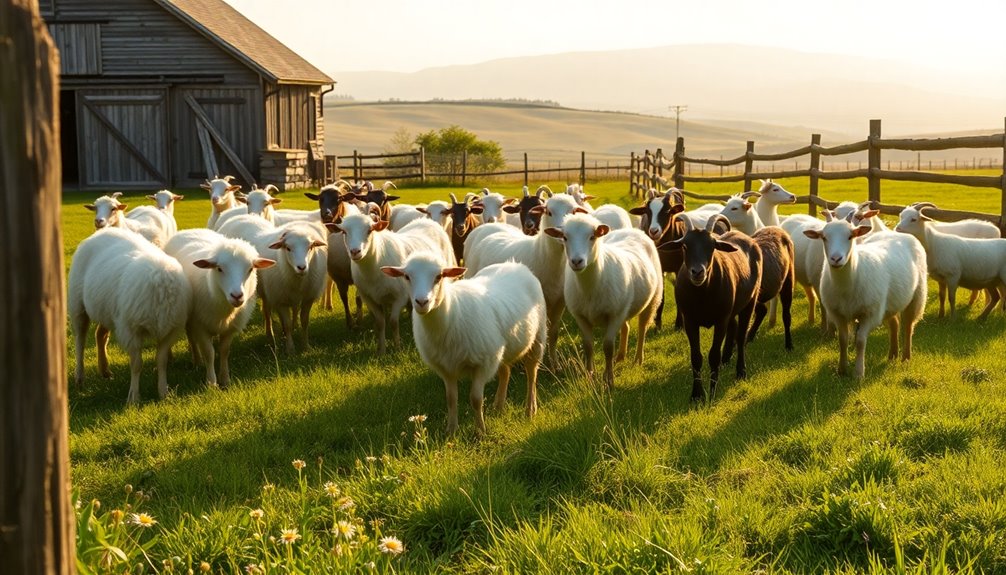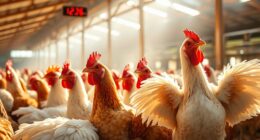Watch for distinct signs in your ewes before lambing. In the last six weeks, their nutritional needs rise, and you should see noticeable udder development and behavioral changes. As they enter early labor, expect them to isolate, experience restless pacing, and have a decreased appetite. Full labor brings more visible changes, including a swollen vulva and evident contractions. Once lambing begins, you'll need to assist if necessary. Keep exploring to learn how to ensure a smooth post-lambing process.
Key Takeaways
- Look for increased udder development and colostrum production about four weeks before lambing.
- Monitor for behavioral changes, including social withdrawal and increased vocalizations as lambing approaches.
- Observe for signs of early labor, such as restlessness, decreased appetite, and vulva swelling.
- During full labor, expect intense contractions, visible water bag, and darkening vulva color.
- After lambing, check that ewes maintain body condition and ensure lambs have adequate milk intake.
Pre-Lambing Signs

As you prepare for lambing season, it's crucial to recognize the pre-lambing signs in ewes, which can help ensure a smoother birthing process.
During the last six weeks of gestation, focus on their nutritional needs, as 70% of fetal growth occurs then. Aim for a body condition score of 3 to 3.5 to prevent pregnancy toxemia.
Watch for udder development, as it becomes firm and full of colostrum about four weeks before lambing. You'll notice behavioral changes, like social withdrawal and increased vocalizations.
Make sure to maintain clean facilities and prepare lambing pens. Regular health checks will help you catch any potential issues early, ensuring both ewe and lambs thrive during this critical time.
Early Labor Signs
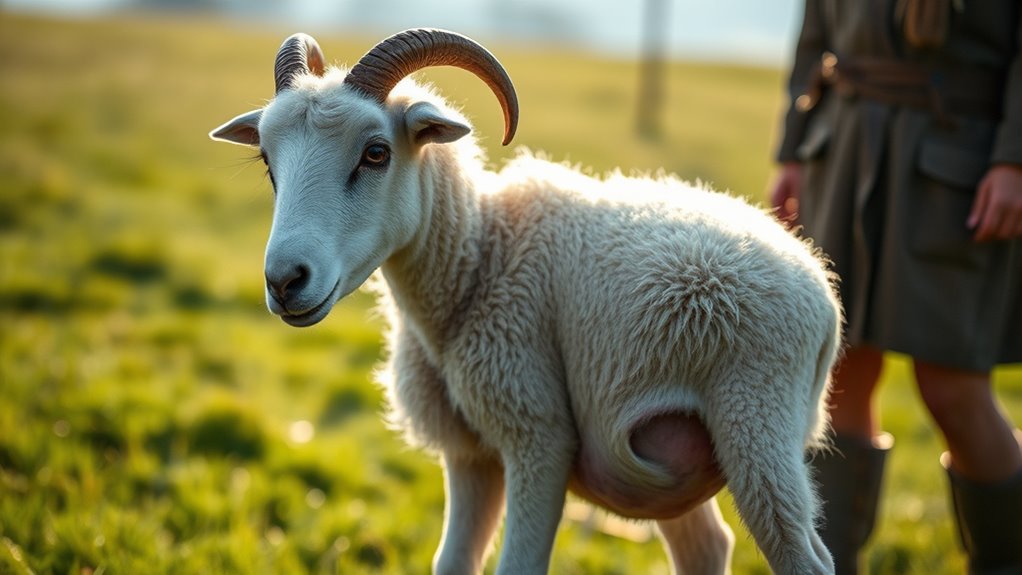
Recognizing early labor signs in ewes is essential for ensuring a smooth lambing process.
You'll notice behavioral changes like pacing and restlessness as they prepare for delivery. Ewes often isolate themselves, seeking safety from predators, and you may observe a decrease in their appetite.
Physically, watch for a change in vulva coloration, swelling, and udder development. The muscles around the vulva will relax, and you might see hollowing of the sides as the lamb shifts.
Additionally, keep an eye out for cervical dilation and mucous discharge. Regular observation is crucial, and having lambing supplies on hand can help you assist if needed.
Be ready to monitor their condition closely as labor progresses.
Full Labor Signs
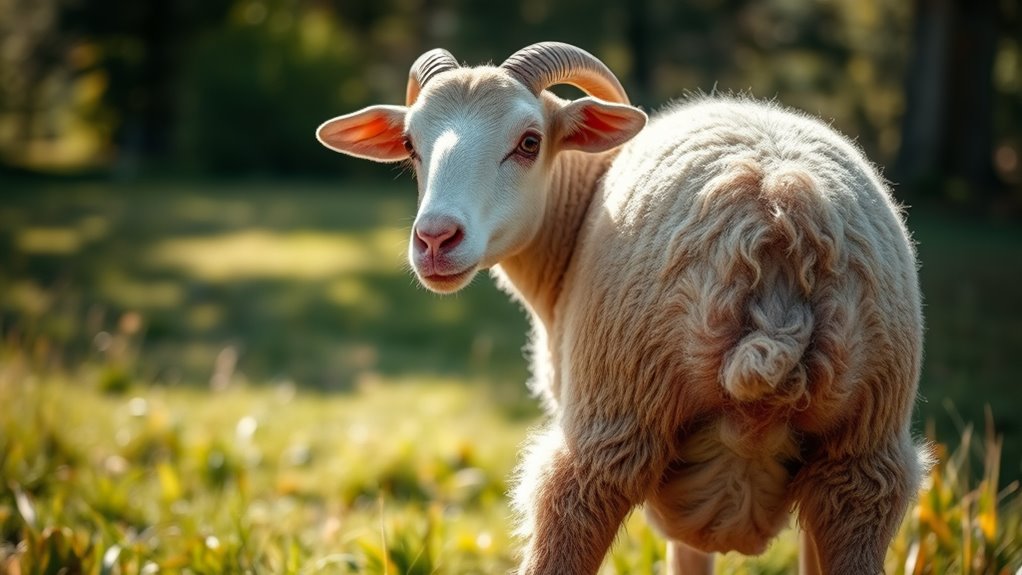
When ewes enter full labor, the signs become more pronounced and urgent.
You'll notice the vulva turning from light to dark pink and swelling as the muscles relax. The udder will feel tight and full of colostrum.
Behaviorally, ewes become restless, pacing and pawing at the ground as they prepare their nesting area. They may stop eating, vocalize more, and isolate themselves from the flock.
Contractions will intensify and occur more frequently, with pushing becoming evident. You might even see the water bag appear, signaling that the lamb is close.
Keep a close watch for any complications and have your lambing supplies ready, ensuring you're prepared to assist if necessary.
Birth Process
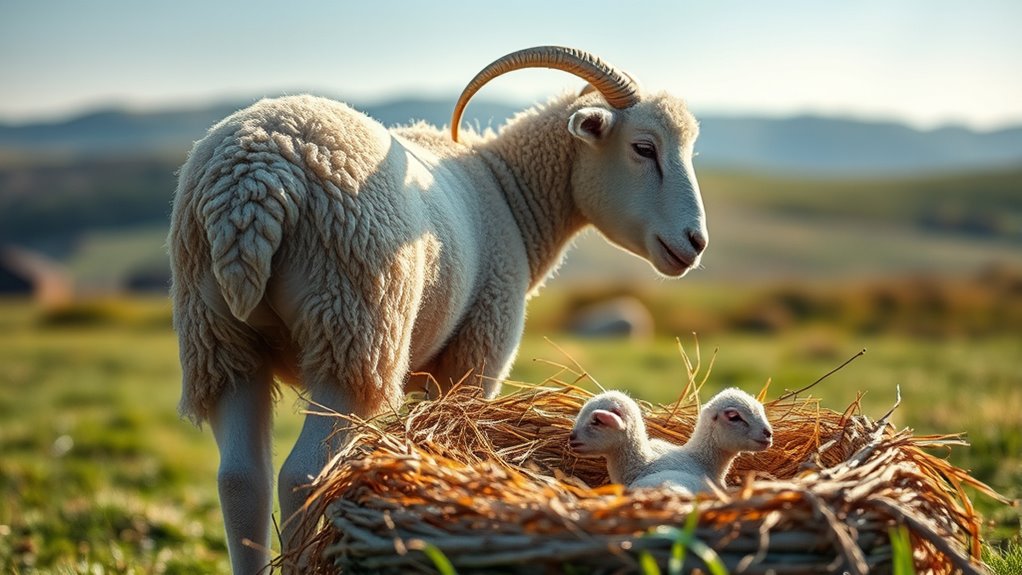
The birth process in ewes, which typically unfolds over about five hours, consists of three key phases: cervical dilation, lamb delivery, and afterbirth expulsion.
During cervical dilation, lasting from two to 24 hours, you'll notice your ewe becoming restless and experiencing a clear-whitish discharge. This signals the cervix is preparing for lambing.
Next comes lamb delivery, usually taking less than two hours. You'll see the water bag rupture, followed by the lamb appearing with forefeet and head first. Your ewe will strain to expel the lamb, requiring patience and observation in case assistance is needed.
Finally, after the lamb is born, the afterbirth will be expelled, completing the birth process.
Post-Lambing Care
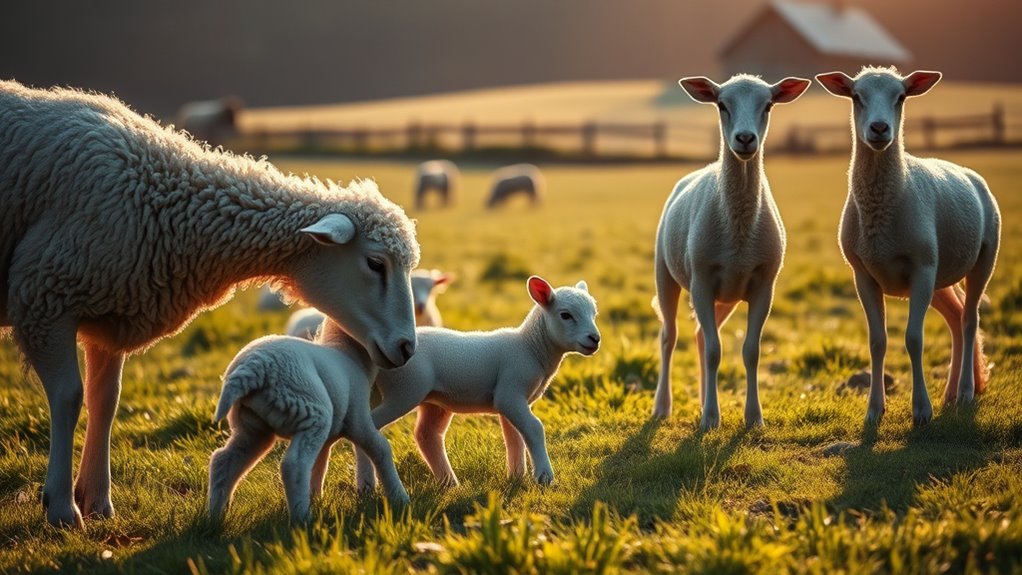
Post-lambing care is crucial for ensuring the health and productivity of both ewes and their lambs. You should maintain ewes at a body condition score of 2.5 during lactation, providing high-fat and high-protein supplements to support milk production.
Post-lambing care is essential for ewes and lambs, focusing on nutrition and health to ensure future reproductive success.
Ensure they've free access to high-quality forage and minerals, but avoid overfeeding in the first 24 hours post-lambing. Administer a dewormer to prevent health issues, and monitor for signs of illness, especially in high-risk ewes.
Regularly check lambs to confirm they're getting enough milk. Keep lambing facilities clean and dry, and move ewes and lambs to grass only after they've bonded.
This proactive care sets the foundation for their health and future reproductive success.
Complications and Assistance
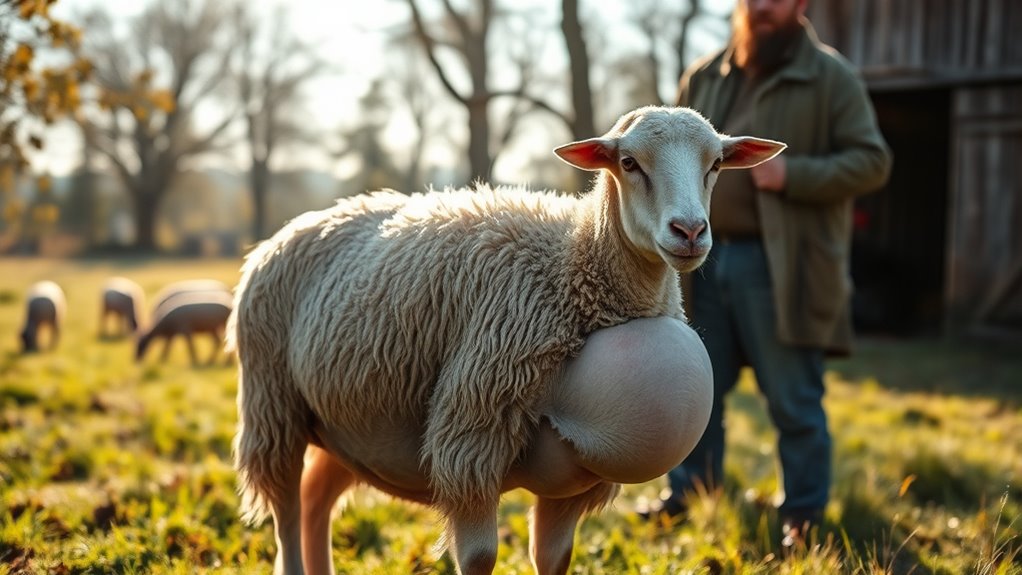
Complications during lambing can arise unexpectedly, making it essential to be prepared and vigilant.
Watch for signs like prolonged labor, where an ewe strains for over an hour without progress, or abnormal presentations, such as a lamb positioned incorrectly. If a lamb gets wedged in the birth canal, you'll need to act quickly to extract it.
Pay attention to any signs of ewe distress; continuous straining without results could indicate serious complications.
Have your lambing kit ready with essentials like disinfectant and obstetrical gloves. If complications like uterine prolapse occur, don't hesitate to call your veterinarian.
Being proactive and knowledgeable about these issues can help ensure a smoother lambing experience for both you and your ewes.
Frequently Asked Questions
How Long Does the Entire Lambing Process Usually Take?
The entire lambing process usually takes several hours to a day.
First, the ewe enters the first stage of labor, which lasts about 3-6 hours, where cervical dilation occurs.
Then, the second stage kicks in, lasting around one hour as the lamb is expelled.
After birth, the ewe and lamb need some time to bond and ensure the lamb nurses properly.
What Is the Ideal Temperature for Newborn Lambs?
The ideal temperature for newborn lambs is crucial for their survival.
You'll want to ensure their body temperature stays between 101.5°F and 103.5°F. If it drops below 99°F, you need to act quickly to prevent hypothermia.
Remember, newborns lose heat rapidly due to their size. Keep them warm, especially in cold or wet conditions.
Providing proper care and monitoring their temperature helps ensure they thrive during those critical first hours of life.
How Can I Identify a Stressed Ewe During Lambing?
To identify a stressed ewe during lambing, watch for signs like straining, back arching, and increased vocalizations.
If she's pacing or isolating herself from the flock, that's a red flag. You might notice a lack of appetite or aggressive pawing at the ground.
Additionally, pay attention to changes in her udder or vulva, as these can signal stress or complications. Observing these behaviors can help you provide timely assistance.
Are There Specific Breeds That Have Different Lambing Signs?
Yes, specific breeds can show different lambing signs.
While most signs are consistent, some breeds might exhibit unique behaviors or physical changes based on their size, temperament, or health predispositions.
For instance, smaller breeds like Babydolls may require more attention due to their size.
It's important to know your breed's characteristics and monitor them closely as lambing approaches, as this can help you anticipate any unique needs or complications.
What Should I Do if a Lamb Is Rejected by Its Mother?
If a lamb's rejected by its mother, you'll need to step in quickly.
Start by bottle feeding the lamb every 2-3 hours, ensuring it gets colostrum for immunity.
Create a warm, safe environment for the lamb to thrive.
If possible, try bonding techniques like scent introduction or confinement with the ewe.
Keep the lamb socialized with other flock members to help it learn normal behaviors.
Patience is key during this process.
Conclusion
In conclusion, keeping an eye on your ewes during the lambing process is crucial, just like watching a clock tick down to midnight. By recognizing the pre-lambing signs, early labor indications, and understanding the birth process, you can ensure a smoother experience for both you and the lambs. Plus, being prepared for post-lambing care and potential complications can make all the difference. Happy lambing season—may it be as rewarding as it is exciting!



